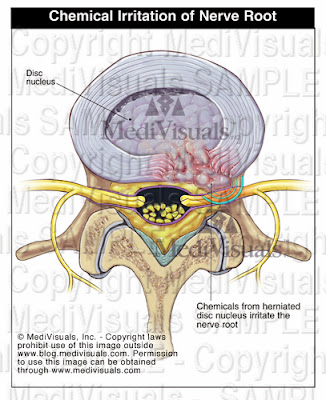Direct compression of an exiting nerve root (see illustration below) is widely appreciated to cause local, as well as, radicular pain and weakness.
However, if a physician's interpretation of a plaintiff's radiology films is that the films show only a bulge that does not compress the nerve root, the problem then becomes to prove that the plaintiff’s pain and weakness are not simply "fabricated".
Discogenic pain is a very likely explanation for local and radicular back pain. The disc itself has numerous sensory nerves called the sinuvertebral nerves. (see illustration below) With an injury to and/or a breakdown of the disc, these nerve endings are also damaged and send pain impulses through the spinal nerve roots.
Another explanation for pain and weakness without direct compression is attributable to chemical irritation of the nerve root due to the breakdown of the nearby disc. This occurs because, as the disc breaks down, chemicals and inflammation irritate the nearby nerve root causing pain and weakness, just as if the nerve root were compressed. (see illustration below)
In review, pain signals from the nerve root whether due to:
- Direct Compression
- Injury to the sinuvertebral nerves
- Chemical irritation of the nerve roots
. . . and are carried to the brain and interpreted in the same way.







No comments:
Post a Comment